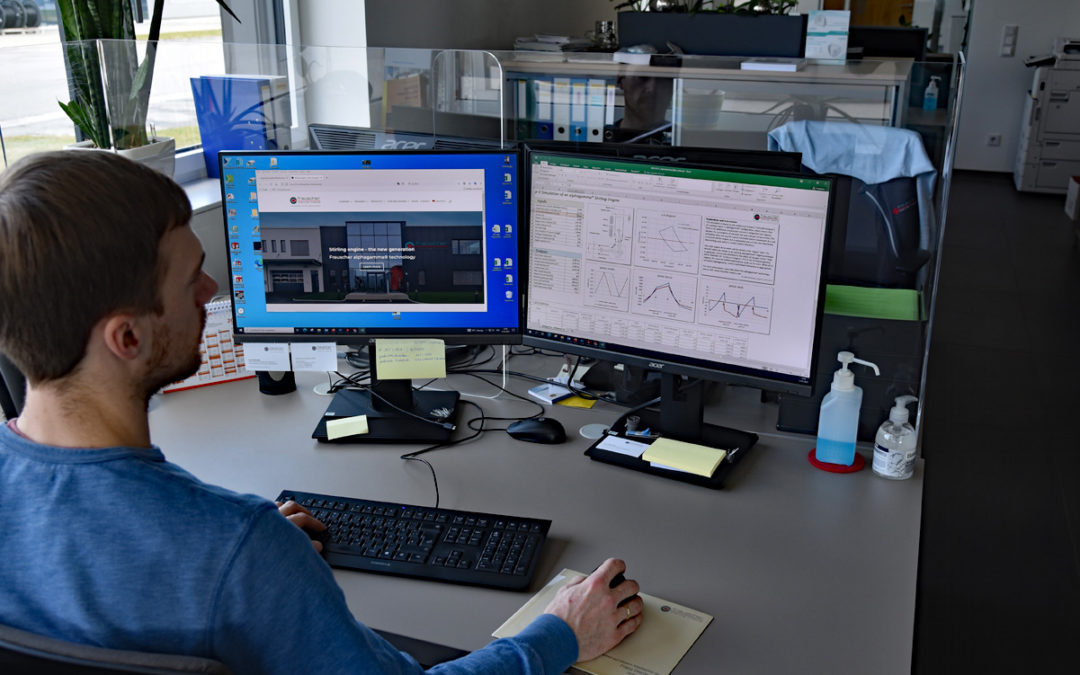To all physics students, thermodynamics freaks or simply technology fans who are interested in gas processes, their behavior and effects: Our Head of QM and Design, Mr. Franz Diermaier, provides you with an Excel calculation tool with which you can achieve amazing effects. You are able to set the following cycle processes:
- Stirling process (beta and gamma configuration)
- Ericsson process (alphagamma® technology)
- Rider process (alpha configuration)
You will also get to know the effects of the alphagamma® technology by being able to influence both the piston forces and the work distribution of the two pistons over a wide range. For the sake of simplicity, we will make the piston movement discontinuous. However, the formulas stored in the calculation program are also suitable for calculating continuous processes. For this purpose, instead of the gradual movement process, the sinusoidal piston movements of the crank mechanism must be set. The results obtained from this already represent a practical process based on the isothermal gas process.
The basis for the calculations is a two-piston engine with a dimensioning that was carried out in a similar form in practice. The core element is a stepped expansion piston (referred to as a displacement piston in the beta and gamma process), the small diameter of which can be set anywhere between 0 and max. The sequence of the piston movements is shown in the “piston strokes” diagram. The piston designation is based on an alpha configuration.
For beginners, the following instructions may give you a first impression:
Step 1: Open the Excel file. Do not change any entries for now.
Step 2: Study the box “Explanation and Instructions” connection with the basic design of the Stirling twin piston engine with 90 degrees cylinder angle.
Step 3: First set the color-coded input in line 6 “Step piston diameter [m]” to the value “0”. You have configured an ideal gamma machine. Consider the P-V diagram which agrees with the typical Stirling cycle. Pay particular attention to the work of the expansion piston (acting here as a displacement piston) in line 29. It has a value of “0”, i.e. this piston does not deliver any work. The horizontal working piston (called the compression piston in the alpha version) does all the work.
Step 4: Of course, a displacer cannot be moved without a piston rod. Therefore, set the value in line 6 “Step piston diameter [m]” to “0.020”, as input for a piston rod with a diameter of 20 mm. You notice that the displacer begins to transform into a working piston. It already gives off a small amount of work of around 28 joules.
Step 5: Change the value in line 6 to “0.063”. This leads to a largely equal distribution of work between the two pistons, the absolute values of which can be read on lines 28 and 29.
Step 6: Change the value in line 6 to “0.090”. The P-V diagram shows a typical Ericsson process curve. The forces of the two pistons are exactly the same, since the piston surfaces acting in the direction of the crankcase are the same.
Step 7: Change the value in line 6 to “0.110”. In this case, there is no longer a stepped piston and the process sequence represents an alpha configuration in a first approximation. In a first approximation because the alpha process (also called the Rider process) contains two isochors, which cause both pistons to move simultaneously. As a result of the large heat exchanger volume selected, the deviations are relative to small values. It is clearly expressed that the compression piston (line 28) no longer delivers useful work, but consumes work.
Further variations: You have the option of changing all values in the “Inputs” fields. We recommend variations in line 11 “gas mass [kg]” first. With this you determine the average pressure of the machine in line 27 and, of course, the work and power. For example, set a specific power (e.g. 10 kW) as the calculation target and experiment with values in lines 6 and 11 that lead to minimum piston forces with the same power. You are well on the way to developing into an expert in Stirling engine technology in a playful way.
We wish you lots of fun experimenting.
Franz Diermaier
franz.diermaier@frauscher-motors.com
Header picture: frauscher thermal motors

